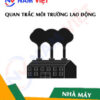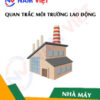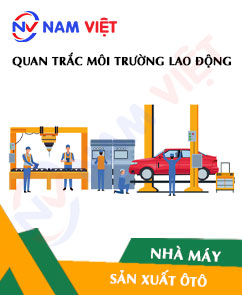Occupational environment monitoring of a beer manufacturing factory
99,000 ₫
Note: The above price is calculated for one sample, and the price may fluctuate depending on the area of the environment to be monitored and market movements. For more accurate pricing support, please refer to the price list or contact our consulting staff directly.
Monitoring the environment of a beer manufacturing factory is a session of collecting, analyzing, and evaluating factors at the workplace that may harm workers health.
Table of Contents
Toggle1. Overview of Beer Manufacturing Factories
a. What is a Beer Manufacturing Factory?
A factory producing beer is an industrial facility that manufactures beer, a beverage made from water, barley or other grains, and yeast. The beer production process includes stages such as ingredient processing, boiling malt with yeast, fermentation, filtration, and bottling or canning.
Beer factories are usually large-scale, equipped with modern and automated technology to ensure efficient production and high product quality. Additionally, they maintain strict quality control standards and procedures to ensure products meet taste, aroma, and safety standards for consumers.

b. Production Stages in Beer Manufacturing Factories
The production stages in beer factories include:
- Ingredient preparation: The main ingredients for beer are water, barley, hops, and yeast. These ingredients are purchased from suppliers and quality-checked before use.
- Ingredient processing: Ingredients are processed to create wort, a liquid from malt. Barley is soaked to activate fermentation and then boiled in a kettle system.
- Fermentation: After wort is boiled, it is cooled, and yeast is added to begin fermentation. This process converts sugars and compounds in the malt into alcohol and carbon dioxide.
- Filtration: After fermentation, beer is filtered to remove sediments and impurities. Methods include sand filtration, diatomaceous filtration, fiber filtration, and membrane filtration.
- Maturation: Filtered beer is matured to allow flavors and aromas to develop.
- Distillation: Beer may be distilled to remove unwanted compounds and achieve a specific alcohol content.
- Bottling or canning: Finally, beer is bottled or canned and packaged for distribution to stores, supermarkets, and restaurants for consumers.

c. Types of Machinery Used in Beer Factories
Beer factories use various machinery to support production and ensure product quality. Common equipment includes:
- Malt grinder: Used to grind barley into flour for production.
- Kettle system: Used to boil barley to create wort.
- Cooling machine: Cools the wort before yeast is added for fermentation.
- Yeast system: Produces yeast to add to wort for fermentation.
- Filtration system: Includes sand filters, diatomaceous filters, fiber filters, and membrane filters to remove impurities from beer.
- Fermentation tanks: Used for maturation to develop flavors and aromas.
- Distillation system: Removes unwanted compounds and produces beer with specific alcohol content.
- Bottling or canning machines: Package beer for distribution to stores, supermarkets, and restaurants.

d. Occupational Diseases for Workers in Beer Factories
Working in beer factories can cause several occupational diseases. Common ones include:
- Pneumonia: Caused by exposure to dust from malt and yeast, with symptoms such as difficulty breathing, dry cough, and chest pain.
- Headaches: Common due to exposure to alcohol fumes in the air.
- Back pain: Repetitive tasks like prolonged standing or sitting can cause back pain.
- Eye irritation: Caused by exposure to strong light and UV from lamps.
- Skin diseases: Workers may develop psoriasis, hives, or dermatitis from chemical exposure during production.
To address health risks in beer factories, occupational health measures such as wearing masks, protective clothing, ensuring ventilation, and maintaining hygiene are necessary.

e. Popular Types of Beer on the Market
There are many types of beer produced worldwide, depending on origin, production method, and ingredients. Popular types include:
- Pilsner: The most popular beer worldwide, made from barley, water, and Saaz hops from the Czech Republic. It has a light yellow color, mild aroma, refreshing taste, and slight bitterness.
- Ale: Made from malt and fermented with yeast at room temperature. Ale has a stronger flavor than Pilsner, with a brown color, bitterness, and hop aroma.
- Stout: Dark-colored beer with a bitter taste and coffee and chocolate aroma. Made from barley and may include corn, oats, wheat, sugarcane, coffee beans, chocolate, and fruit.
- Lager: Fermented at lower temperatures than Ale for 1 to 6 months. Lager has a light flavor and pale yellow color.
- Wheat beer: Made from wheat, with a light, refreshing taste and aroma of orange, lemon, hops, and spices.
- Pale ale: Light yellow with a bitter taste, made from barley, water, and hops.

2. Overview of Occupational Environment Monitoring Services
a. What is Occupational Environment Monitoring in Beer Factories?
Occupational environment monitoring (or workplace environmental measurement) in beer factories is the activity of collecting, evaluating, and analyzing workplace environmental factors to implement timely measures that minimize harm to workers’ health and prevent occupational diseases. Monitoring is mandatory for beer factories.
Occupational environment monitoring plays a crucial role in protecting and enhancing worker health, as employees are the main resource and directly generate profit. Workers exposed to harmful factors exceeding allowable limits may suffer health issues and occupational diseases.
REGISTER FOR OCCUPATIONAL ENVIRONMENT MONITORING SERVICE
b. Nam Viet’s Occupational Environment Monitoring Program
Nam Viet’s program is designed by monitoring engineers in occupational safety and environmental protection. Aiming to ensure health and safety, it uses modern measurement methods to monitor air, water, microclimate, physical, and dust factors in the workplace. This program is essential for a safe working environment and protecting workers’ health.
Additionally, the program contributes to research and development of new solutions to improve workplace quality. With dedicated and professional specialists, Nam Viet’s exclusive monitoring program represents a breakthrough in occupational safety and environmental management in Vietnam.

c. Standardization in Workplace Measurement Procedures
Standardization in Nam Viet’s measurement process ensures the accuracy and reliability of results. The program follows recognized standards and procedures of Ho Chi Minh City Department of Health, guaranteeing highly reliable data for evaluating workplace conditions and making improvements.
Standardized procedures ensure measurements are conducted by qualified monitoring specialists with years of experience, allowing managers to trust the results and make informed decisions for worker health and environmental protection.
By applying standardization, Nam Viet demonstrates its commitment to safe working environments and contributes to improving occupational safety and environmental management in Vietnam.
d. Reporting of Monitoring Results in Beer Factories
Monitoring results are prepared according to Form 04, Appendix III of Decree 44/2016/ND-CP, and issued in two copies: one for the factory and one for the monitoring organization.
Records are stored indefinitely according to legal regulations.

e. Frequency of Occupational Environment Monitoring According to the Law
According to Clause 2, Article 18 of the Law on Occupational Safety and Hygiene 84/2015/QH13, employers must organize monitoring to assess harmful factors at least once a year.
f. Deadline for Submitting Monitoring Reports According to the Law
Reports must be submitted by December 31 annually. Businesses must submit monitoring results to the local Department of Health where the factory is headquartered and where employees work.
If there are changes in technology, production processes, or facility upgrades that may introduce new harmful factors, businesses must update occupational hygiene records regarding factors requiring monitoring.
g. Penalties for Violations of Occupational Environment Monitoring by Employers
According to Article 27 of Decree 12/2022/ND-CP dated 17/01/2022 on administrative penalties in labor and social insurance:
- Clause 2: Fine from 2,000,000 to 5,000,000 VND for employers who fail to publicly inform employees about monitoring results and risk assessments immediately after results are available.
- Clause 3: Fine from 20,000,000 to 40,000,000 VND for employers who do not conduct monitoring to control health risks as required by law.
- Clause 4: Fine from 40,000,000 to 60,000,000 VND for employers colluding with monitoring organizations to falsify monitoring results, without reaching criminal liability.
3. Harmful Environmental Factors for Workers in Beer Manufacturing Factories
Workers in beer manufacturing factories may encounter the following harmful environmental factors:
- CO2 Gas: The beer production process uses CO2 to create pressure in tanks and bottles. Exposure to high concentrations of CO2 can be dangerous to workers’ health, causing headaches, difficulty breathing, dizziness, loss of consciousness, and potentially death.
- Toxic fumes: Beer production may generate toxic fumes from solvents, cleaning agents, and dyes. Prolonged inhalation can cause health issues such as headaches, fatigue, breathing difficulties, respiratory inflammation, and burns.
- Contamination: Beer factories must handle and eliminate microorganisms during production. Improper handling can lead to contamination in the workplace, posing health risks to workers.
- Noise: Machinery in beer factories often operates continuously and produces loud noise. Persistent high noise can cause health problems such as stress, hearing loss, and vibration-induced shock.
- Lighting: Production areas often have strong lighting, especially UV light. Exposure to UV light can damage eyes, reduce vision, and cause eye inflammation.
REGISTER FOR OCCUPATIONAL ENVIRONMENT MONITORING SERVICE
4. Measures to Improve the Working Environment in Beer Manufacturing Factories
Measures to improve the working environment in beer factories may include:
- Pollution control: Factories need to manage emissions, liquid and solid waste to minimize negative impacts on the environment and employees’ health.
- Improve ventilation and natural lighting: Ensure sufficient natural light and airflow to reduce air pollution and improve workers’ health and performance.
- Employee training: Train staff on occupational safety, environmental protection, and safe production procedures to reduce workplace accidents and protect the environment.
- Use personal protective equipment: Provide masks, gloves, gowns, and safety shoes to minimize risks during work.
- Improve nutrition: Factories can provide employees with nutritious meals and ensure food hygiene to boost health and productivity.
- Periodic health checks: Organize regular health examinations to detect and treat work-related illnesses early and protect employees’ health.
- Regularly conduct occupational environment monitoring in factories, collecting and analyzing harmful factors, and adjusting measures to reduce risks and prevent occupational diseases.
5. Benefits of Periodic Monitoring in Beer Manufacturing Factories
An Toan Nam Viet provides enterprises with excellent benefits when using occupational environment monitoring services according to Decree 44/2016/ND – CP on managing and controlling harmful factors in the working environment affecting employees.
- Enterprises can proactively control harmful factors in workshops or factories.
- Receive consultation and recommendations to reduce harmful factors and improve workplace quality.
- Indirectly protect human resources, a key factor in business development.
- Reduce the impact of occupational diseases on health, minimizing future treatment costs.
- Improved employee health enhances product quality and maintains consistent production output.
- Comply with occupational safety laws, avoiding legal risks.
- Enhance credibility and professionalism, thereby elevating the enterprise’s brand.
Nam Viet’s environmental monitoring service is a solution to reduce occupational disease risks, contributing to a clean and high-quality working environment.

6. Nationwide Occupational Environment Monitoring Center
Occupational Environment Monitoring Center of Nam Viet is a professional unit specializing in monitoring and measuring occupational environment quality across all provinces in Vietnam. With an experienced team of monitoring specialists, the center uses modern measurement equipment to ensure accuracy and reliability.
In addition to providing monitoring services, the center assists clients in planning, handling, and tracking occupational environment issues. Following the principle “customer-centered,” the center prioritizes client satisfaction, meets all client needs, and commits to providing the best solutions for enterprises.
REGISTER FOR OCCUPATIONAL ENVIRONMENT MONITORING SERVICE
With investment in technology, equipment, and human resources, Nam Viet’s monitoring center has become a reputable unit in occupational environment monitoring in Ho Chi Minh City, with the following goals:
- We always value brand reputation and service quality.
- We provide clients with the best and most suitable solutions.
- Alongside experienced Masters and Engineers, aiming to protect the environment and benefit enterprises.
- By choosing Nam Viet Environmental Monitoring, your company will receive professional service from experts in monitoring, along with the best cost incentives.
The occupational environment monitoring process at Nam Viet includes the following steps:
- Before monitoring, we ensure that all machinery and equipment used for monitoring are calibrated and compliant with legal regulations.
- Conduct the full monitoring procedures as committed to the Department of Health.
- Report monitoring results honestly to the employer.
- If results indicate unsafe conditions, Nam Viet will assist with corrective measures, and the factory will implement the following:
- Implement measures to improve working conditions, minimize harmful factor impact, and prevent occupational diseases.
- Organize health checks for early detection of occupational and work-related diseases for workers in unsafe positions.
- Provide material compensation for workers according to labor law regulations.

7. Occupational Environment Monitoring Price List
To help enterprises conduct occupational environment monitoring professionally and effectively, Nam Viet provides clients with a price list for occupational environment monitoring services that is high-quality and reasonably priced.
- Our price list provides detailed information on the costs of monitoring services, including transportation, measurement, analysis, and reporting. Clients can fully trust the accuracy and reliability of our monitoring reports.
- We commit to offering competitive and reasonable prices and are always ready to answer any questions about monitoring services promptly and professionally.
- With Nam Viet’s price list, clients can easily select service packages that suit their needs. We guarantee the highest satisfaction with professional service quality.
No comments yet












Review Occupational environment monitoring of a beer manufacturing factory
There are no reviews yet.